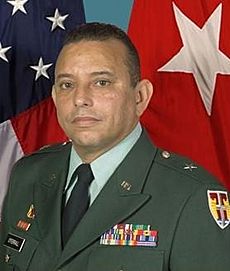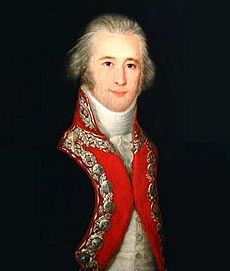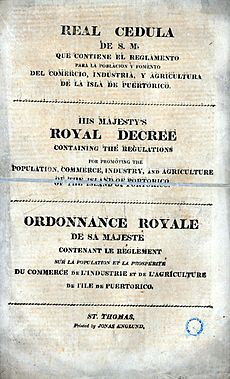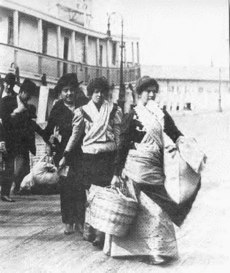Irish immigration to Puerto Rico facts for kids
Irish immigration to Puerto Rico started a long time ago, when Spain was colonizing the island. It continued through the 1800s and still happens today. In the 1500s, many Irishmen were called "Wild Geese". They left the English Army and joined the Spanish Army. They did this in Europe or by leaving English ships near Puerto Rico. They often joined the Spanish army in San Juan.
Many of these Irish soldiers stayed in Puerto Rico after their military service. They often asked their families from Ireland or Spain to join them. Some married local women from the island.
In the 1700s, important Irish military leaders like Field Marshal Alejandro O'Reilly and Colonel Thomas O'Daly came to Puerto Rico from Spain. Their job was to make the capital city's forts stronger. This led to even more Irish people moving to the island, as these soldiers brought their families.
In 1797, the Spanish governor of Puerto Rico, Ramón de Castro, tried to make all Irish people leave the island. But the Puerto Rican people protested right away. They respected the Irish community for their strong support. Most of the Irish who left during this time came back quietly to live in Puerto Rico.
In 1815, the Spanish government created the Royal Decree of Graces. This law encouraged Catholic Europeans who were not Spanish to move to Puerto Rico and Cuba. Spain hoped this would stop the independence movements growing in these colonies.
Many Irish people left their homeland because of the terrible Great Famine in the 1840s. Over a million people died from this famine. Many Irish moved to the United States. But a lot of them came to Puerto Rico instead. This happened after they were turned away from American ports because of sickness on their ships. Many of these Irish settlers helped a lot with the island's successful sugar industry. This industry was very important for the local economy.
After Spain gave Puerto Rico to the United States in 1898, many American soldiers of Irish background were stationed there. They met local people who also had Irish roots. These soldiers often stayed in Puerto Rico. They quickly became part of the Irish, non-Irish, and native communities across the island.
The Irish influence in Puerto Rico is not just about farming. They have also helped in education, arts, sciences, and politics.
Contents
Irish Soldiers in Spain's Army
Starting in the 1500s, the English Crown slowly took control of Ireland. Sir William Stanley, an English Catholic, was asked by Queen Elizabeth I to create an army group in Ireland. This group was made only of Irish soldiers. The English wanted to send these Irish men out of Ireland because they saw them as a threat. These Irishmen were sent to fight for England to help the Dutch provinces become independent. At that time, Habsburg Spain was fighting the Dutch.
However, in 1585, Stanley switched sides and joined Spain. He took his many Irish soldiers with him. He did this for religious reasons and because Spain offered him money. These Irishmen who left the English Army to join other countries' armies became known as the "Wild Geese." One of these "Wild Geese" was Alejandro O'Reilly. He was an Inspector-General for the Spanish Empire. He helped improve the military and was called "The Father of the Puerto Rican Colonial Militia." Another Irishman, Colonel Thomas O'Daly, helped him a lot.
Important Irish Figures in the 1700s
In 1765, the King of Spain, Carlos III, sent Field Marshal Alejandro O'Reilly to Puerto Rico. His job was to check the island's defenses. O'Reilly took a full count of the island's population. He suggested many changes, like making the local soldiers follow strict rules. He also said that soldiers should get their pay regularly and directly.
Some of O'Reilly's ideas led to a big 20-year project to update San Felipe del Morro Castle in San Juan. This fort is now a World Heritage Site.
The training O'Reilly started made the Puerto Rican militia famous 30 years later. This was during the British invasion of Puerto Rico in 1797. Field Marshal O'Reilly's citizen army was known as the "Disciplined Militia." O'Reilly later became governor of Louisiana in 1769.
Another Irishman, Colonel Thomas O'Daly, worked with Field Marshal Alejandro O'Reilly. They improved San Felipe del Morro. O'Daly became the chief engineer for updating San Juan's defenses, including the fortress of San Cristóbal. Later, he received land near Guaynabo. O'Daly turned this land into a successful sugar farm.
O'Daly and another Irishman, Miguel Kirwan, started a business together. They called their farm "Hacienda San Patricio" after Saint Patrick, the main patron saint of Ireland. The farm no longer exists. The land is now a neighborhood called San Patricio with a shopping mall.
O'Daly married a local woman named María Gertrudis de la Puente. She was of Spanish background. They had three children: Isabel, Manuel, and Demetrio. He easily joined the growing Irish community on the island. This community became important for the growth of farming businesses.
When Thomas O'Daly died in 1781, his brother Jaime took over the property. Jaime helped raise Thomas's children. In 1787, the Spanish Crown made Jaime O'Daly the director of the Royal Tobacco Factory in Puerto Rico.
Jaime O'Daly became a successful sugar and tobacco farmer. His nephews, Julio and Arturo O'Neill, moved to Puerto Rico in 1783 with their workers and farm tools. Thomas Armstrong, another Irish farmer, followed them in 1791.
O'Daly's connections with other Caribbean and European nations helped him financially. O'Daly stayed in Puerto Rico and died in 1806. He was buried in the San Juan Cathedral.
Joaquín Power y Morgan, who had Spanish, Irish, and French family roots, came to Puerto Rico. He was involved with a company that managed the slave trade on the island. He married María Josefa Giralt, who had Catalan and Irish heritage. They lived in San Juan. In 1775, they had a son named Ramón. Their son would have a great career serving both Spain and Puerto Rico.
Ramón Power y Giralt became a respected captain in the Spanish Navy. He defended the Spanish colony of Santo Domingo from French forces by blocking their ships from 1808 to 1809.
Power y Giralt was the first Puerto Rican born on the island to call himself a Puerto Rican. He became Puerto Rico's representative to the Spanish Cortes (a legislative assembly) in 1808. He later became its vice president. He served there until he died in 1813.
Demetrio O'Daly, Thomas O'Daly's son, went to Spain for military training when he was young. O'Daly fought in the 1809 Peninsular War. He was promoted to brigadier general during Spain's war for independence. O'Daly supported the Spanish Constitution of 1812. Because of this, King Fernando VII saw him as a rebel and sent him away from Spain in 1814.
In 1820, he took part in a successful revolt against the Spanish monarchy. This led to him becoming a Field Marshal. He was then chosen as Puerto Rico's representative to the Spanish Cortes. One of his achievements was a law that separated the civil government from the military on the island.
In 1823, O'Daly was sent away again by the Spanish Crown. He returned to Puerto Rico in 1834. He went back to Spain in 1836 and died the next year.
Miguel Conway, Patricio Fitzpatrick, Felipe Doran, Jaime Kiernan, and Antonio Skerret were other Irishmen who farmed in northern Puerto Rico. They grew their farms with the help of more Irish immigrants they brought to the island.
Their properties stretched from Toa Baja in the northeast to Luquillo in the east. At one point, Kiernan owned 400 acres (1.6 km2) of land in Hato Rey, making his total land 800 acres (3.2 km2).
Irish Contributions to Sugar and Tobacco
Irish immigrants played a very important role in growing Puerto Rico's economy and trade with Europe and other European colonies.
One of the island's most important industries was sugar. Besides Thomas O'Daly, whose farm was very successful, other Irishmen also became successful in the sugar business. These included Miguel Conway, who owned a farm in Hatillo, and Juan Nagle, whose farm was in Río Piedras.
Puerto Ricans of Irish background also helped develop the island's tobacco industry. Miguel Conroy is known for starting the tobacco trade in Puerto Rico. Another Irish family, the Quinlans, started two very profitable tobacco farms. One was in Toa Baja and the other in Loíza.
Irish Expulsion and Return
On February 17, 1797, Puerto Rico's governor, Brigadier General Ramón de Castro, learned that Britain had taken the island of Trinidad. He thought Puerto Rico would be next. So, he prepared the local army and the island's forts for a possible attack.
After Spain won the Battle of San Juan of 1797 against Great Britain, Governor de Castro became suspicious of all English-speaking foreigners. He wrongly believed they supported the British. He ordered some local residents and foreigners, especially those of English and Irish descent, to be watched. Many were given eight days to leave the island. Those who did not leave were put in prison.
The people in Puerto Rico were very angry about de Castro's actions. They sent special messengers to Spain to speak for the Irish community. They told the Spanish Crown that the governor's actions were unfair and bad for the economy. They strongly believed that the Irish immigrants had already proven their loyalty to Spain. They were also valuable partners who helped Puerto Rico trade with Spain and other colonies. Eventually, the Irish and their families who had been temporarily banned returned to the island. This included the O'Dalys, Dorans, Kiernans, Quinlans, O'Ferran, Butler, Killeleigh, and Skerrets, among many others.
In 1823, Robert and Josiah Archibald, who were Irish brothers, brought the island's first steam-powered mill to Puerto Rico. They used it successfully on their sugar farm in Ponce. By doing this, they showed even more how important the Irish community was to Puerto Rico's economy.
The 1800s and New Arrivals
Royal Decree of Graces of 1815
By 1825, the Spanish Empire had lost almost all its colonies in the Americas, except for Puerto Rico and Cuba.
However, these two places had been asking for more self-rule since 1808. Spain realized it might lose its last two Caribbean colonies. So, it brought back the Royal Decree of Graces of 1815.
This time, the decree was printed in three languages: Spanish, English, and French. The main goal was to attract Europeans who were not Spanish. Spain hoped that new settlers would make the independence movements less popular. Also, free land was offered to those who wanted to move to the islands. The only conditions were that they had to promise loyalty to the Spanish Crown and to the Roman Catholic Church.
Among the many Irish families who received free land was Angus McBean's family. The McBeans started a large sugarcane farm in Bayamón. In 1821, workers on McBean's farm were involved in a failed revolt planned by Marcos Xiorro.
During this time, the O'Neill family arrived in Puerto Rico from Spain and other Caribbean islands like Tortola and St. Croix. They joined the already growing Irish community.
Many Puerto Ricans with the O'Neill last name can trace their family history to Colonel Arturo O'Neill O'Keffe. He was the son of Tulio O'Neill O'Kelly and Catherine O'Keffe y Whalen. On August 8, 1828, O'Neill O'Keffe, a Knight of the Royal Order of King Carlos the 3rd of Spain, served as a lieutenant colonel in the Spanish army in Bayamón. He was married to Joanna Chabert Heyliger.
Arturo and Joanna O'Neill's children were Tulio Luis, Arturo, Micaela Ulpiana, and Gonzalo. All of them had the last names O'Neill (from their Irish father) and Chabert (from their French mother). All, except Tulio Luis, were born in Puerto Rico. They married and raised their families there.
The Great Famine
Because of many changes in Europe in the late 1700s and early 1800s, many farm workers and their families left the countryside. They moved to bigger cities to find better jobs.
Those who stayed on their farms suffered from widespread crop failures. This was caused by long dry periods and diseases like cholera and a potato fungus. This fungus caused the Great Irish Famine in the 1840s. Many people across Europe starved. In Ireland, the Great Famine killed over a million people. It also created almost two million refugees. These refugees went to Great Britain, the United States, Australia, Canada, New Zealand, and the Caribbean. One island that many Irish families moved to during this time was Puerto Rico, which was friendly to the Irish. Also, since Puerto Rico was a Spanish colony, most of its people were Roman Catholic. This appealed to the Irish immigrants. Many colonies of the British Empire and the United States at that time were mostly Protestant and not as welcoming to Irish immigrants.
Irish Influence in Modern Puerto Rico
After Spain gave Puerto Rico to the United States in 1898, many Irish-American soldiers stayed on the island. They met other people of Irish descent there. Unlike Irish immigrants in the United States who often stayed in their own communities, the Irish on the island quickly became part of Puerto Rican society. They learned the language and customs. This had been happening since the first Irish people arrived in the 1500s. Irish immigrants in Puerto Rico often married Puerto Ricans.
The Irish influence in Puerto Rican politics is also important. After Pedro Albizu Campos left the United States Army, he went to Harvard University in Boston, Massachusetts. While in Boston, he started groups where young Irish people met. They talked about their homeland's independence. Éamon de Valera invited Albizu Campos to help write the Irish Free State constitution. After Albizu returned to Puerto Rico, he joined the Puerto Rican Nationalist Party. He soon became the party's president. Pedro Albizu Campos used the Irish republican movement as a guide for the Nationalist Party.
Irish Impact on Puerto Rican Culture
Besides their important work in farming and the military, Puerto Ricans of Irish descent have made many other contributions. Their impact can be seen in education, business, politics, science, and entertainment.
Among the O'Neill family, whose contributions are still seen today, are Héctor O'Neill, who was the Mayor of Guaynabo. Also, Ana María O'Neill was an educator, writer, and supporter of women's rights.
Puerto Rican beauty queens of Irish descent who represented their country in the Miss Universe pageant include: Ada Perkins, Miss Puerto Rico (1978), Deborah Carthy Deu, Miss Universe 1985, and Laurie Tamara Simpson, Miss Puerto Rico (1987).
The Irish presence in Puerto Rico is very clear. Their help in farming and in politics and education is very noticeable. In the city of Bayamón, there is a neighborhood called Irlanda Heights (Ireland Heights). For several years, the town of Luquillo has held a day-long Saint Patrick's Day festival. It includes a Desfile de San Patricio (St. Patrick's Parade) honoring Ireland's main patron saint. There are also several Irish pubs around the island that celebrate the holiday and serve green beer. These include Shannon's Irish Pub in San Juan and Logan's Irish Pub in Río Piedras.
Common Irish Surnames in Puerto Rico
| Surnames of the first Irish families in Puerto Rico | ||||
| Anderson, Armstrong, Balfour, Ballantine (Valentin), Branagh, Breslin, Butler, Carney, Cole, Coll, Coleman, Coney, Conroy, Conway, Cooper, Costello, Davis, Darby, Dilan, Dylan, Donegal, Doran, Dunn, Dunaho, Duran, Ferran (O'Ferran), Finlay, Fitzgerald, Fitzpatrick, Gilbert, Hayes, Henna, Kelly, Kearney, Kennedy, Kiernan, Kilkenny, Killeleigh, Kinsella/Quinsella, Kirwan, Logan, Martin, Mayo, McComber, McConnie, McClintock, McCormick, McDougall, McKinney, Monaghan, Monroe, Morgan, Munro, Murphy (Morfi), Murray, Nagle, Nolan, O'Daly, O'Ferral (O'Farrell), O'Ferran (Ferran), O'Fray, Oliver, O'Hara, O'Mara, O'Neill, O'Reilly, Perkins, Power/Powers, Quinlan, Richardson, Roberts, Scanlon, Shanahan, Simmons, Simpson, Skerret, Sullivan (Sólivan/Soliván), Todd, Walker, Williams and Wilson...among others. | ||||
See also
- Cultural diversity in Puerto Rico
- Irish diaspora
- List of Puerto Ricans
- O'Neill dynasty







